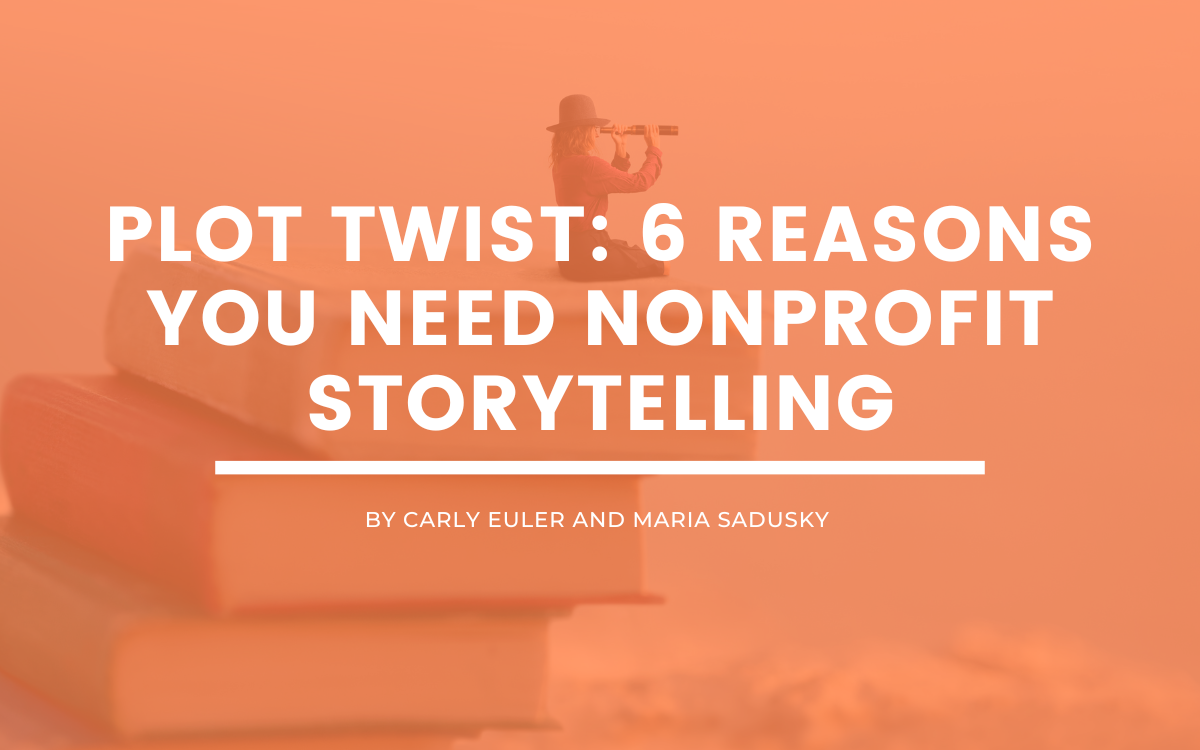Plot Twist: 6 Reasons You Need Nonprofit Storytelling
4 min to read ✭
Nonprofits are doing incredible boots-on-the-ground work every single day. Raising awareness. Providing education. Planting trees. Supplying food. Combating homelessness. Performing life changing research. You name the issue, and there is an incredible organization working hard to overcome it with nonprofit storytelling.
So how do you set your organization apart?
Differentiation is key, and storytelling is the most effective way to do it.
For nonprofits, telling your story — and empowering others to tell it on your behalf — is essential in building and sustaining critical connections with your community, volunteers, and donors. And these days, visual content MUST be part of the equation.
6 Reasons You Need Nonprofit Storytelling
Here are 6 reasons why you need to embrace and integrate nonprofit storytelling into your marketing and fundraising efforts:
-
Nonprofit Storytelling Humanizes Your Mission
The United States is home to more than 1.5 million nonprofit organizations. People have plenty of options when deciding where to invest their time, money, and resources. On top of that, many community issues are complex and intangible, making it difficult for the general public to fully grasp the magnitude of the problem. From cancer support groups and animal rescues, to education and social justice initiatives, the nonprofit sector encompasses a wide range of causes.
Through storytelling, nonprofits can translate abstract concepts into relatable narratives that capture the attention and empathy of their audience. Personal stories humanize the impact, enabling individuals to better understand the challenges faced by the community and the role nonprofits play in creating positive change.
Photo and video content has never been more important when it comes to sharing your impact with your target audiences. Access these free 12 Months of Gratitude Canva Templates to get started making compelling content using your great stories.
-
Great Stories Empower Your Biggest Fans
When you’re looking for a new dining experience, it’s one thing to read on a restaurant’s website that they’re the #1 Italian restaurant in the city. It’s another — and much more telling — to read reviews from past patrons.
The same is true when it comes to nonprofits championing a cause. No matter how impactful your mission statement may be, people are no longer satisfied just taking your word for it. Instead, they want to hear it directly from someone else. Nonprofit leaders are often their organizations’ biggest advocates, but empowering fans – your board members, your program participants, your volunteers and your donors – to tell your story is what will truly make a difference.
Nonprofit storytelling puts a spotlight on the people who have been most directly impacted by their efforts: someone whose life has changed through volunteering, a student who was able to continue their education because of scholarship funds, a cancer survivor who hopes to see funding for a cure. These are the impactful stories that leave the biggest mark.
STORYTELLING TIP: Every person is not a natural-born storyteller. Therefore, asking the right questions can make a massive difference when capturing that memorable, shareable content. Check out these 20 interview-style questions to help guide your storytellers in order to harness incredible community-generated content.
-
Nonprofit Storytelling Enhances Transparency
Transparency is crucial in establishing trust with donors. Nonprofits must provide transparent information about how the donated dollars and cents will be utilized effectively. When sharing these details, storytelling techniques can be employed to illustrate the journey from inception to completion, showcasing the impact of each step along the way.
Donors appreciate knowing how their contributions will make a difference, and transparency enhances their confidence in the organization, increasing the likelihood of their continued support. With donor retention rates hovering between 40% – 45%, communicating transparency is not something that can be ignored!
-
There is Power in Capturing Raw Emotion in Real Time
When you watch an award show, they always have cameras on the faces of all the nominees when they announce the winner. Why? Because there is something inherently powerful about capturing raw emotion in real time.
Your organization may not be handing out Oscars, but the premise remains the same. Great stories are told with elements of emotion – hope, happiness, excitement, relief – which can only be felt authentically at that very moment, in real time. Capturing the elation of a family moving into their first home debt-free, or the hopeful eyes of a student receiving a scholarship to attend their dream school, is not something you can adequately convey at a later date.
To demonstrate impact, nonprofits can no longer just tell, they need to show.
STORYTELLING TIP: The power of visual storytelling through graphic design can be a game-changer for your cause. Whether it’s creating eye-catching social media posts, compelling donation campaigns, or impactful event materials, graphic design plays a crucial role in inspiring action. Explore these 5 Graphic Design Tips for Nonprofits to take your graphic design to the next level.
-
Narratives Are (More) Unforgettable
There’s a reason your uncle has been telling the same story at every holiday gathering for the last 30 years. It’s the same reason the stories you read to your kids are the same ones your parents read to you. Stories, and feelings they evoke, are unforgettable.
And we’re not just saying that! According to the Stanford Graduate School of Business, stories are remembered up to 22 times more than facts alone. While a potential donor may not know your exact mission, they will remember the video they saw that told the story of a local family experiencing job loss and food insecurity who found resources at your food pantry.
The facts, figures, and data points that nonprofits invest so much time gathering and reporting certainly have their value, but at the end of the day, these real-life stories of your efforts in action are what resonate the most.
-
Great Stories Inspire Action
62% of social media users say they’ve become more interested in a product or brand after seeing it in short-form videos. At the end of the day, the goal of any nonprofit is to inspire people to act: donating, volunteering, signing a petition, contacting public officials, attending an event – you name it!
While impact numbers are an incredible way to demonstrate the positive changes your organization has provided, to the outside world, impact numbers can be challenging to conceptualize. And when humans cannot conceptualize something, they lose interest.
Therefore, to truly inspire action, we recommend contextualizing your impact numbers with a powerful story. By sharing compelling stories that highlight the real-life experiences and transformations resulting from their work, nonprofits can effectively demonstrate the impact they have on their communities.
Overall, nonprofit storytelling has the unique ability to connect with donors on an emotional level, helping them understand the impact of their contributions and inspiring them to support a cause. There is no time to waste – start your nonprofit storytelling journey today!






